China’s Wealthiest Cities 3: The Demographics
Nov. 12 – In an article we ran earlier this week on China’s wealthiest cities, we identified and discussed the top 10 cities in China according to disposable income levels. Yesterday, we took a closer look at Shenzhen, Shanghai, Guangzhou, Wenzhou and Hangzhou which made up the top five cities on the list. Today, we will look at the other half of the top 10 and provide our readers with key information on the Chinese cities of Beijing, Suzhou, Dongguan, Tianjin and Wuxi.
Beijing: Disposable income RMB26,738
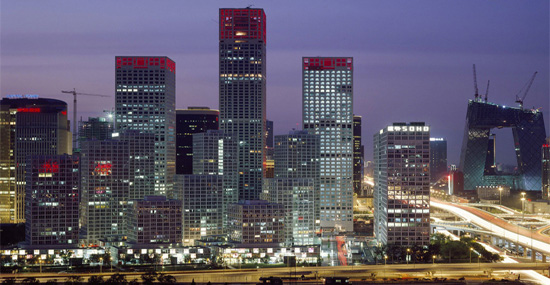
Beijing is the political, cultural, national and international exchange of China, and one of the world’s most famous historic and cultural cities and ancient capitals. Although Shanghai and Hong Kong are predominantly known to be the economic centers of the country, Beijing is rapidly catching up. This is reflected in its government-backed initiative to build the Beijing Financial Street, which aims to become the city’s version of Wall Street. In preparation for its role as host of the 2008 Olympics, the city underwent a massive makeover that has greatly improved transportation and communications infrastructure.
Fast facts
- Services have become Beijing’s main industry and the city wants its tertiary industry to contribute 72 percent of its GDP this year
- Olympics related construction and other developments gave the city’s economy a RMB1 trillion boost in 2008
- Beijing is engaged in a major digitization program
- Pollution and serious shortages of water, energy and land are longstanding problems in Beijing and will likely pose a challenge for investors and the government
Infrastructure
Nine expressways are currently linked to Beijing, with more to come. These include the Badaling, Jingcheng, Airport, Jingtong, Jingha, Jingshen, Jingjintang, Jingkai and Jingshi expressways. It is projected that the web of expressways around Beijing will eventually number as many as 15 with the new additions (Jingping/Jingji, Northern Jingjin, Southern Jingjin, 2nd Airport Expressway, Northern Airport Expressway and Litian expressways).
On a grander scale, plans are on the drawing board for seven national expressways including one bound straight for Taiwan. The newly planned expressways will link with Hong Kong/Macau, Urumqi, Lhasa, Harbin, Shanghai, Taipei and Kunming, among other cities. Road freight facilities are also being enhanced, with the construction of five freight terminals at Majuqiao, Yancun, Tianzhu and Shibali Laiguangying.
As the rail hub of the nation, Beijing has four major passenger railway stations: Beijing Railway Station (Central Station) which serves the routes to the north and east of the city; Beijing West Railway Station, which is Asia’s largest rail terminal serving the south and the west; and Beijing South Railway Station and Beijing North Railway Station, which mainly serve the suburban short-distance routes. In addition, the Beijing East Station and Fengtai Railway Station were built and used as auxiliary passenger railway stations.
Beijing’s railway network boasts 10 major railway lines and has recently completed the highspeed railway system between Beijing andTianjin. To compete with airlines, the construction of regional high-speed railways has developed rapidly in recent years. Bullet trains link Beijing with six major cities starting from mid-2007. The trains travel at speeds of between 200 and 250 kilometers per hour between the capital and the six cities of Shanghai, Wuhan, Shenyang,Changchun, Harbin and Qingdao, reducing journey times by an average of two hours. The journey between Beijing and Shanghai now takes 10 hours. Ticket prices for the bullet trains are 50 percent more than the current express trains, which usually travel at 115 kilometers per hour. Non-stop express trains would also start to operate between Beijing and the three cities of Nanchang, Nantong and Fuzhou.
The Beijing-Shanghai high-speed line which will be able to travel at 300 kilometers per hour is currently under construction and will reduce the journey time between Beijing and Shanghai to just five hours once it is completed. An estimated 220,000 passengers per day will be able to use the trains. The new rail line will have 24 stations, including Tianjin, Jinan, Xuzhou, Bengbu and Nanjing. China hopes to complete the line by 2011, but engineers have said that construction could take at least until the middle of the decade. The total cost of the new line is expected to be RMB220.9 billion.
Beijing’s links with Tianjin have also been improved, reducing the journey to just 30 minutes, with the development of a 115-kilometer long high-speed rail line that travels up to 300 kilometers per hour.
The Beijing subway network has eight lines covering over 200 kilometers of track. Several lines were added for the 2008 Olympics including Line 4, Line 5, Line 10 and a light railway to Capital International Airport.
The Beijing Capital International Airport is located in the northeast of the city, 26 kilometers from the city center and has three terminals. Passenger Terminal 1 is designed to serve 60 flights daily and 1,500 passengers at peak hours. More than 5,000 scheduled flights are available to 88 cities in China and 69 cities abroad. Terminal 2 can handle 26,500,000 passengers yearly at 9,219 passengers at peak hours.
The airport’s capacity has been greatly enhanced with the 244-acre third passenger terminal. Built to cater to the traffic during the 2008 Olympic games, Terminal 3 has been operational since March 2008. The government is also seeking a site for the construction of a second capital airport either in the city of Langfang, in Hebei province, or at the Nanyuan Airport to the south of Beijing.
Traffic in the city center is often gridlocked even outside rush hours. Even with plans of the 7th Ring Road currently underway, the city center remains a virtual parking lot during rush hours. The public transportation system is still underdeveloped compared to other major cities.
Economy and investment climate
Beijing’s GDP for 2009 was US$173.7 billion, an increase of 10 percent compared to the year before. Its per capita GDP increased amounting to US$10,070 in 2009. Beijing’s tertiary industry accounted for the majority of the municipal’s total output in 2009 at RMB900.45 billion. Primary industry was worth RMB11.83 billion and secondary industry worth RMB274.31 billion.
In 2009, Beijing’s exports reached US$48.4 billion, a decrease of 15.9 percent while imports amounted to US$166.4 billion, down by 22.3 percent. The city was ranked 4th in the country in terms of foreign trade.
Beijing’s current focus is to encourage investment in three major areas: IT development in the Zhongguancun Science Park, industrial development in the Beijing Economic-Technological Development Area, and real estate development in the Central Business District, for which the municipal government itself plans to invest some US$1.5 billion.
The central business district, located around the East Third Ring Road in the China World Trade Center area, will be its business center, attracting corporate headquarters into an area that is striving to become China’s version of Manhattan. The Financial Street district here is poised to be China’s Wall Street.
Beijing has some of the nation’s biggest and best science and technology research centers and is home to 82 universities and colleges.
Suzhou: Disposable income RMB26,320
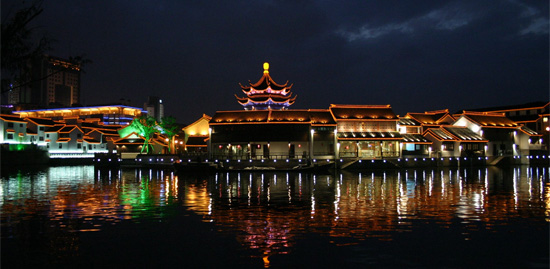
Nicknamed “Venice of the East,” Suzhou has a reputation for beautiful landscapes as well as citizens. Its excellent location ensures the development of trade as well as tourism within the city. Lying in close proximity to Shanghai whose costs are rising steeply, the city has in recent years attracted huge amounts of FDI much of which is directed into the prosperous and conveniently located in the Suzhou Industrial Park.
Fast facts
- Suzhou is one of China’s most prosperous cities with an extremely high per capita GDP
- Suzhou is 45 minutes from Shanghai by train and 1.5 hours from Nanjing
- The city is the world’s top manufacturer of laptops and digital cameras
- The government plays a major role in invigorating the local economy – known as the “Suzhou Model” of economic development
- Some of the classical gardens in Suzhou are UNESCO World Heritage Sites
Infrastructure
Suzhou is set to become a “super-large” city within the next 10 years. The downtown area will be expanded into an area bounded by highways surrounding the city, while the western boundary will be extended one kilometer towards Lake Tai.
Suzhou is known as the southeast gate to Shanghai and Zhejiang Province because of its welldeveloped highway network. Three long-distance bus stations are now in use. The Suzhou North Bus Station has the most bus routes to Anhui, Hubei, Fujian, Shandong, Jiangxi, and Zhejiang Provinces. Buses depart for Shanghai from the station once every 20 minutes.
Other driving options include the Jiangsu-Shanghai Expressway, the Yangtze Riverine Expressway, and the Suzhou-Jiaxin-Hangzhou Expressway. In 2005, the Suzhou Outer Ring was completed, linking the peripheral county level cities of Taicang, Kunshan, and Changshu.
Suzhou is an important city on the Beijing- Shanghai Railway line as well as the Jinghu Railway linking Shanghai and Nanjing. There is an hourly railway service to both cities. Suzhou Railway Station is among the busiest passenger stations in China, having 139 trains stopping daily.
Despite being an important tourist destination, Suzhou does not have its own international airport yet. It is best to use the nearby airports in Shanghai – Shanghai Hongqiao International Airport and Pudong International Airport. Hongqiao Airport is 86 kilometers away from Suzhou. Shuttle buses run daily between the airport and Suzhou, taking about one hour, 40 minutes.
China’s Grand Canal, which reaches north to Tong County in Beijing as well as south to Jiaxing and Hangzhou in Zhejiang Province, passes by Suzhou and has been an important means of water transportation for many years.
Economy and investment climate
Suzhou has enjoyed tremendous growth in the last five years as Shanghai’s cost of manufacturing has risen, which has allowed Suzhou to offer similar investment experience, but with lower costs. In 2008, Suzhou’s GDP was RMB670.1 billion, an increase of 13 percent. During the same period, retail sales reached RMB155.17 billion.
To sustain Suzhou’s growth, and its place in the Chinese economy, the Suzhou government takes an active part in invigorating the local economy. It acts in accordance with market economy rules as well as laying out an explicit blueprint to attract investors. Unlike many areas of China that only focus on building the hardware, Suzhou has also invested heavily in the software required to effectively attract investment.
As Shanghai continues to grow, Suzhou only stands to benefit. In addition to capturing the overflow of many companies who find Shanghai too expensive, many suppliers to those manufacturing in Shanghai are located in Suzhou’s parks and the surrounding area. Due in large part to its proximity to Shanghai,
Suzhou was one of the first regional cities that foreign companies looked at when settingup manufacturing. More and more foreign companies are continuing to move to Suzhou in order to open new factories and take advantage of the lower land and labor costs.
Cumulative contracted FDI increased by over 470 percent from US$7.23 billion in 2001 to US$16.4 billion in 2008. Used FDI increased from US$3.02 billion to US$8.13 billion in the same period. For Suzhou, a city that has planned its economy to support and benefit from the growth of nearby Shanghai, the foresight and planning has paid off. Many foreign executives located in Shanghai look to Suzhou before anywhere else for further investment as operations can be managed from Shanghai if need be. Foreign managers living in the city say that Suzhou’s quality of life has improved dramatically in the last three years, and as a result they are willingly to move operations to the city.
Suzhou has 25 colleges, 70 research institutions, and every year more than 50,000 graduates hit the streets to contribute to the future skilled labor force that Suzhou requires in order to drive its industry forward.
Dongguan: Disposable income RMB25,320
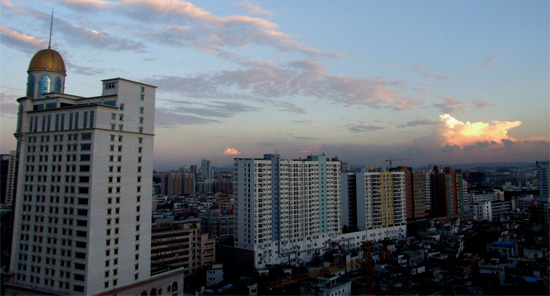
Dongguan is a major manufacturing base with more than 10,000 industrial operations including computer parts manufacturing as its backbone. There is also a transportation hub connecting Guangzhou, Hong Kong and the harbors along the Pearl River.
Fast facts
- Dongguan is one of the world’s largest production bases for microwave ovens
- The city is located 50 kilometers from Guangzhou, 90 kilometers from Shenzhen, 47 nautical miles from Hong Kong and 48 nautical miles from Macau
- The city, including its surrounding area, is the third largest exporting region in China, behind only Shanghai and Shenzhen
Infrastructure
Dongguan has been developed into a major transportation hub in the Greater Pearl River Delta. In 2005, the city announced a planned investment of US$500 million over five years for technology infrastructure improvements.
A well-developed highway system comprises the 107 National Highway, Guangdong –Shenzhen highway and Dongguan-Shenzhen highway running south and north. The government invested RMB17 billion in the construction of a 139-kilometer highway covering the Donguan sections of the Baoluo-Shenzhen, Guangzhou-Shenzhen, Huizhou-Changzhou, Conghua-Dongguan, and Panyu–Houjie highways.
The city is at the center of the Guangzhou-Hong Kong Economic Corridor, and also the meeting point of the Guangzhou-Kowloon, Guangzhou-Shenzhen, Guangzhou-Shantou and the greater Beijing-Kowloon railways. Direct train services go to Guangzhou East railway station; and Hung Hom KCR station in Hong Kong.
Within 50 kilometers of the city center is an international airport in Guangzhou and another in Shenzhen to the south. Hong Kong international airport is only a two hour drive away. There are many civil aviation agencies in Dongguan.
Humen Port in Dongguan has 18 docks with a capacity of 1,870 tons. The Guangzhou Huangpu Port, Xinsha Port, Shenzhen Yantian Port and the Shekou container dock all are within a one hour drive. The city is only two hours Hong Kong’s container dock. An investment of RMB7.9 billion has been allocated for the construction of the Humen Port in the 29 kilometer zone of Lisha Island.
Economy and investment climate
Since the country’s compliance with the WTO, the city’s economy has changed from traditional agriculture to commercialized agriculture and eventually to an industrial society. Twenty-five years ago, Dongguan was an impoverished farming village where residents struggled to survive on limited rice allocations. Today, its 14,000 foreign-controlled factories make it one of the world’s largest production bases for microwave ovens. It is also a major producer of everything from computer cables to furniture and computer displays.
Dongguan’s GDP in 2008 was US$370.25 billion. The city is the third largest exporting region in the country, behind Shanghai and Shenzhen.
The National Development and Reform Commission identified the city as one of the most significant growth regions for technology in the coming years.
The city’s 20,000-plus enterprises produce more than 60,000 products across 33 industry sectors. With the electronics industry as the core, its industrial sector comprises of niche clusters such as machinery, electrical appliances, textiles and garment, furniture, and footwear.
It is also an international processing and manufacturing base as well as one of China’s leading export centers capable of supplying 95 percent of the parts and components for its computer manufacturing. At present, the IT industry is the dominant industry in the city, making it an important production base for computers and related products.
Dongguan receives a significant amount of Taiwanese investment. Taiwanese companies such as Taida electronics and Baocheng Group are just some of the famous brands there. More than half of Taiwan’s IT manufacturers have shifted their production lines to the mainland since 2000 due to rising labor costs.
Along with Guangzhou, Shenzhen and Huizhou, the city forms an electronic and IT industrial corridor that produces monitors, mother boards, power supply systems, scanners, keyboards, mouse, video cards, chassis, enclosures and modems.
The government has been working hard to attract foreign investment in the city. Affected by the global financial crises, foreign trade value in Dongguan increased 6.1 percent to US$113.3 billion in 2008, compared with 26.9 percent in 2007. The export value rose 8.9 percent year on year to US$65.5 billion. The growth rate saw an 18.1 percent decease. The processing trade, a major type of foreign trade in Dongguan, was hit badly. The foreign trade value of processing trade witnessed a rise of 4.3 percent in 2008, a much smaller rise than the 25.1 percent in the previous year.
The city has a qualified workforce due to its investments in education. More than US$1.2 billion has been spent to improve both general middle schools and vocational schools. There is also an estimated 700,000 people who attend training courses annually.
Tianjin: Disposable income RMB21,402
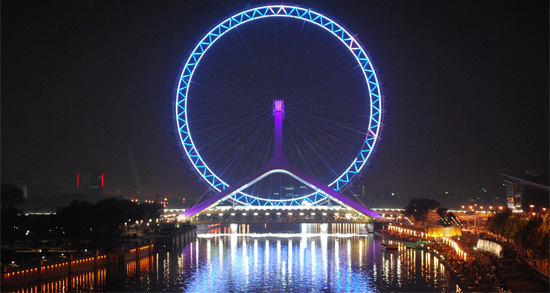
The significance of Tianjin has grown rapidly over the last century and a half. After the founding of the PRC, Tianjin became a designated municipality on level footing administratively with other provinces. Beyond the downtown area, huge new developments have been taking place, including TEDA, one of the largest and most famous development zones in the country.
Fast facts
- Tianjin is the largest producer of mobile phones and related components in China
- Tianjin Port is the largest in Northern China and is second only to Shanghai in Mainland China
- The city has several large and important development zones, notably the very well-known TEDA
- Despite being close to Beijing, the cost of living and labor is significantly less than that in the capital, and there is an abundance of competitively-priced land
Infrastructure
Tianjin has three ring roads – the Outer Ring Road is the closest thing to a highway-level ring road, although traffic is often terrible. There is a four-lane carriageway expressway running from Beijing to Tianjin. Six state expressways and national highways connect Tianjin with major cities including Harbin, Fuzhou, Macau, and Guangzhou.
The new, high speed rail link between Tianjin and Beijing has reduced travel time between the to cities to 30 minutes from two hours.
Tianjin Binhai International Airport is located about 13 kilometers east of the city center. After total renovations are completed, the airport will be able to handle 10 million passengers, 500,000 tons of cargo and 200,000 flights a year. China’s first private airline, Okay Airways Company Ltd, set up its hub at Binhai International Airport, and made its maiden flight in March 2005. The airline deals with charter passenger services, domestic air cargo and mail transport.
Tianjin Port has one of the largest ports in China and is a key shipping hub of the region, with established ties to more than 300 ports in 160 countries and regions.
The Hong Kong subway operator MTR Corporation signed an agreement with the Tianjin government in December 2004 to develop the subway system in the city. It began trial operations in March 2006. This development is built on top of an older system, opened in 1984, which did not succeed. The city currently has 50 stations and 4 lines in total comprising theTianjin Metro and Binhai Mass Transit. There is talk of having a total of six lines by 2050, totaling 154 kilometers.
Economy and investment climate
Despite its size and importance as a port, the city lacks the vitality of other large Chinese coastal cities, and has been unable to attract the same degree of investment as places such as Guangzhou and Shanghai. However, new development is increasing rapidly and Tianjin is now catching up with nearby cities such as Beijing.
Tianjin is the cradle of the modern machinery and weaving industries in China. It is part of Bohai Bay Economic Zone, which is one of the three largest economic zones in China. In 2009, Tianjin’s GDP hit RMB750.1 billion. Exports amounted to US$42.2 billion while imports reached US$38.3 billion in 2008, an increase of 10 and 14 percent respectively.
Tianjin’s industry centers around six core industrial sectors, namely information technology, automotive, chemicals, metallurgy, medicine, new energy sources and environmental protection-these combine to produce over 70 percent of Tianjin’s total industrial output. It is also an export-processing base for a wide range of products, and in particular machinery, transport equipment, raw materials and mineral fuels.
Tianjin is close to rich reserves of petroleum and natural gas. Petrochemicals is thus a major sector in the city, and Sinopec will spend US$3 – US$4 billion to expand its Tianjin plant to meet surging demand for petrochemicals in northern China. China’s biggest oil-refinery plans to more than double the crude processing capacity of its Tianjin refinery from six to 14 million tons per year. When completed in 2012, the Tianjin facility will become one of the largest integrated oil refining and petrochemical projects on the mainland.
As many as 122 of the Fortune 500 enterprises have invested in the city, including big names like IBM and Motorola. The first overseas manufacturer of the Airbus-A320 general assembly line has also been established in Tianjin. Tianjin has an educated workforce with 37 higher education institutions, including Tianjin and Nankai Universities, as well as eight state-level laboratories, 10 state-level engineering technical research centers and 27 technical examination centers. Over 600,000 technical staff and 10,200 foreign experts reside in Tianjin ranking the city third in China with regard to its scientific force.
Wuxi: Disposable income RMB17,175
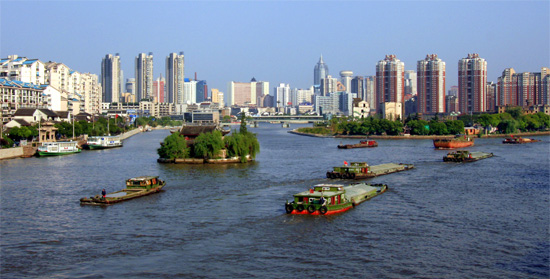
A local official once said “if Suzhou is Silicon Valley, then Wuxi is Detroit.” They were no doubt referring to the city’s focus on traditional secondary industries. Although the agriculture sector accounts for less than 5 percent of the city’s economy, Wuxi has recently absorbed 13 small towns and 400,000 former farming communities into its boundaries. Despite its thick and fast development Wuxi is still a very beautiful place, with tranquil lakes and mountains.
Fast facts
- Wuxi is situated in southern Jiangsu Province and covers an area of 4,788 square kilometers with a population of 4.64 million
- The city developed by increasing textile production and adding more heavy industries
- The city is also listed as one of China’s 15 key economic centers
- Wuxi is one of the top 50 cities in China with comprehensive strength, and among the top 40 cities in China with an excellent investment environment
Infrastructure
Nine highways connect Wuxi with important cities like Shanghai, Nanjing and Hangzhou. The Shanghai-Nanjing Railway and Shanghai-Nanjing Expressway pass through the city. Both Wuxi-Jiangyi Expressway and Jiangyin Yangtze River Highway Bridge have been opened to traffic in recent years, as well as State Highway No. 312 and 104.
Wuxi is conveniently situated on the Jinghu Railway, linking it directly with the provincial capital of Nanjing and Shanghai, both only two hours away. Xinyi-Changxing Railway is under construction.
Wuxi Airport, which opened in 2004, is situated 14 kilometers from downtown and has six airlines offering direct flights to Beijing, Guangzhou, Shenzhen, Hong Kong and other major Chinese cities. The city is also situated 180 kilometers from Shanghai Pudong International Airport, 120 kilometers away from Shanghai Hongqiao International Airport and 180 kilometers from Nanjing Lukou International Airport.
By relying on the Yangtze, the Grand Canal and the Lake Tai, Wuxi has seven waterways which connect to different places. The city center is 40 kilometers away from Jiangyin and Zhangjiang Harbors, which handle shipments to more than 140 countries and regions worldwide. Furthermore, Wuxi is 165 kilometers from the port of Shanghai and only 38 kilometers from the port at Jiangyin.
Economy and investment climate
Although the land area and population is small relative to other Chinese cities, Wuxi’s contribution to the country’s entire economic volume is vast. Per capita GDP in Wuxi was RMB73,053. In 2008, Wuxi’s GDP was RMB441.93 billion.
The city has evolved from a primarily textile-based industry in the early 20th century to its present day status where it now relies on five key sectors, namely electronics and IT, fine chemicals, precision machinery, metallurgy and high grade garments. Heavy industry still makes up for 75.4 percent of all of Wuxi’s industries. The city has around 36,000 enterprises with over 6,000 production lines. There are 60 of the world’s leading 500 companies with operations in Wuxi. One of these companies is Caterpillar, which plans to build engines here as well as base its engine R&D projects in the city. The company’s facilities will eventually produce over 100,000 engines per year.
Wuxi’s industrial scale ranks seventh within China’s mainland cities with its high technological level also leading the way. In recent years, Wuxi has become a major manufacturing base in the YRD area and is also developing production-oriented services to help transform the city into an international manufacturing base with a business-friendly environment. The city is now also placing priority on the environment, with several proposed projects being rejected on grounds of pollution worries, while existing heavy polluters will not be allowed to expand their business.
Contracted FDI reached US$5.13 billion in 2008, while the total used FDI increased by an impressive 14.2 percent to US$31.67 billion. Imports and exports have also grew to US$20.2 billion and US$35.7 billion respectively.
Related Reading
China’s Wealthiest Cities 2: The Demographics
China’s Wealthiest Cities: Highest Disposable Income
China’s Fastest Growing Provinces: The Demographics
China’s Fastest Growing Cities: The Demographics
Economist China Summit: The Debates Discussed
China’s Second Tier Cities? The Third and Fourth Are Catching Up
 Business Guide to China’s Emerging Second and Third Tier Cities
Business Guide to China’s Emerging Second and Third Tier Cities
Provides a thorough analysis of 50 of China’s emerging cities, featuring economic data, infrastructure and investment climate reviews, and a directory to development zones, business associations, media and major hotels in all locations. (217 pages, US$25)
 Business Guide to Beijing and Northeast China (Second edition)
Business Guide to Beijing and Northeast China (Second edition)
A detailed overview of Beijing and Northeast China, including the provinces of Hebei, Heilongjiang, Jilin, Liaoning and Shandong. (184 pages, US$25)
 Business Guide to Shanghai and the Yangtze River Delta (Third edition)
Business Guide to Shanghai and the Yangtze River Delta (Third edition)
A detailed overview of Shanghai and the Yangtze River Delta, including the provinces of Anhui, Jiangsu, Shanghai and Zhejiang. (188 pages, US$25)
 Business Guide to South China and the Greater Pearl River Delta (Second edition)
Business Guide to South China and the Greater Pearl River Delta (Second edition)
A detailed overview of South China, including Hong Kong, Macau, and the provinces of Guangdong, Fujian, Guangxi and Hainan. (196 pages, US$25)
 Business Guide to Central China
Business Guide to Central China
A detailed overview of Central China, including the provinces of Hebei, Henan, Hubei, Inner Mongolia, Jiangxi and Shanxi. (120 pages, US$25)
A detailed overview of West China, including the provinces of Gansu, Guizhou, Ningxia, Shaanxi, Sichuan, Tibet, Xinjiang and Yunnan. (172 pages, US$25)
- Previous Article China’s CPI Hits Highest Rate in Two Years
- Next Article The RMB Position and the Mysteries of the China Unemployment Fund










